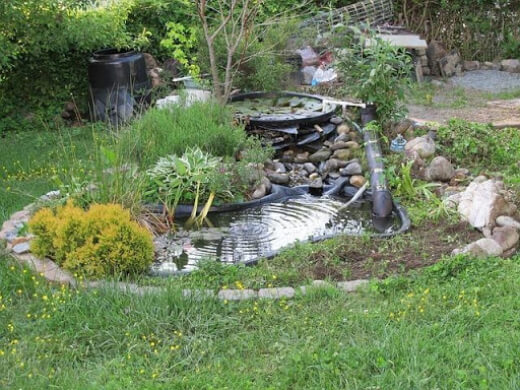Are you planning to add a pond to your garden? Ponds and water features are a great idea to add to your landscape. You need to properly plan and design the pond plumbing system including the flow, drainage and filtration of water for the functionality and ecosystem of the pond.
A backyard garden pond is a beautiful addition to a home, with its relaxing scenery and tranquil natural sounds. Ponds are even more soothing with the addition of a water feature such as a waterfall or a fountain.
Here we have a list of the pond plumbing features you will need to keep your pond and water feature healthy.
More...
Water Feature and Pond Plumbing List

Piping for Your Water Features
The piping will transport the water for your pond or water feature from the source of origin to the pump. PVC pipes are a plumber’s first choice when it comes to the piping for water features.
PVC is widely known for being affordable, durable, and safe to use. There are two types of PVC piping, which are rigid PVC and flexible PVC. Either one has its advantages and disadvantages.
Rigid PVC pipe is most commonly used for larger ponds due to its ability to withstand pressure. The only downside is, you would need to heat it for it to bend. Rigid PVC pipe works best for being the main pipe or for longer pipe runs.
On the other hand, flexible pipes are better suited for smaller ponds and good for DIY use since it is easier to bend on every turn and can be directly hooked up to the filter.
Despite being easier to install, it’s not as tough as the rigid PVC type. It may not be able to withstand pressure if installed beneath soil or rocks where it can be disfigured or damaged.
The walls are also ribbed for flexibility which causes friction and resistance adds a little more work for your pump. Flexible PVC pipes work best for ecosystem ponds where pipe runs are shorter and have simpler water feature plumbing requirements.
Choosing the Right Pond and Water Feature Pump
In selecting a water pump, it is recommended to choose one that is reliable enough to function without interruptions, can turn over the full volume of the pond every hour, and is energy efficient.
To choose the right pump for your pond and water feature, you need to know what you need to consider first.
- Determine the volume of the pond – This depends on what type your pond is. The following is the formula to use so you can get the volume of the pond.
- For square or rectangular ponds, you can use the following formula: Length x Width x Average water depth (in feet) x 7.5
Ex. 5 ft x 6 ft x 2 ft x 7.5 = 450 gallons - For Circular ponds, it is measured as follows: Diameter x Diameter x average water depth (in feet) x 5.9
Ex. 5 ft x 5 ft x 2 ft x 5.9 = 295 gallons
- Determine the flow rate – After getting the volume of your pond, you now have an idea of how much water volume a pump needs to pump out every hour.
This is the flow rate measured as gph (gallons per hour). If you’re adding a waterfall, you will need to add about 100 gph or 200 gph per inch based on the height of the waterfall from the water surface. - Understand the head pressure – This is the resistance that your pump must overcome to release the water out to the other end of the pipe.
Factors that add to head pressure are the filters, pipes, fittings, or the height of the waterfall from the surface of the pond.
After this, you can choose whether you’d prefer a submersible pump or an external pump. Each of them is sorted to how much gph one pump can handle.
A submersible pump is easy to install, you just simply drop it in the water. External pumps may require priming, but they require less routine maintenance than submerged pumps.
Both submersible and external pumps can thrust the same level of water but external pumps are more expensive. Still, it is recommended to invest in high-efficiency pumps such as external pumps as it uses less electricity thus saving money and less wastage therefore better for the environment.
If you’d like some help deciding which pump is best for your pond, it’s advisable to hire a professional plumber to identify the right pump and install the pumping system properly.
Pond and Water Feature Filter
Your water feature and pond plumbing are not complete without a filter. You can manually filter out dirt from the surface of your pond with a net, but it doesn’t get all the dirt and debris in the water.
Installing an automatic skimmer system will clean your pond from algae, dirt, and other debris making it healthy and safe for your fish and other aquatic pets.
Although costly, an automatic skimmer system is ideal as it removes the debris before it sinks to the bottom of the pond. Installing a water filter will improve the water quality and appearance therefore making it a healthier environment for any little critters making your pond a home.
Water Feature and Pond Plumbing Guide Summary
Building a pond is a fun and rewarding experience. Be sure to also see our guide on pond aeration. Nevertheless, the installation of the pump and filtration system can be a little tricky and difficult.
It is still best to hire a professional when it comes to installing these crucial systems for your pond to avoid spending more of your money and time in fixing mistakes.
Doing it right from the beginning can help finish the pond plumbing faster so you can relax and be enjoying your pond in no time.
